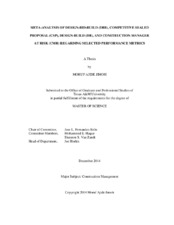| dc.description.abstract | The need for a one size fits all type of project delivery system still persists within the architecture, engineering, and construction (AEC) industry. However, owners still feel the need for a more refined system that could help meets their various demands within time and budget. These demands in part are due to the performance benefits the various project delivery system offers to project stakeholders. Ranging from higher project complexity to the level of communication and integration, these project delivery systems have been used to produce world class buildings and state-of-the-art projects. Unlike competitive sealed proposal (CSP), over the decades, traditional low bid design-bid-build (DBB), construction manager at risk (CMR), and design-build (DB) has gained significant credits and awareness in the industry due to their vast popularity and usage in different varieties of project type in the U.S and around the world.
Several studies however have been conducted to quantify these performance benefits and wastes levels, in terms of the commonly used metrics namely; time, unit cost, cost growth, delivery speed, schedule growth, production rate, safety, project change, and project quality. This paper meta-analytically organizes and summarizes decades the construction literature that quantifies the differences in performance benefits and waste levels between DBB, CSP, DB, and CMR project delivery methods in terms of project cost growth, schedule growth, project change, and quality to unfold the trends, patterns and/or identifies possible differences in the results. Findings reveal that despite several research efforts, few studies present statistically significant comparative results between the studied project delivery systems for all the identified key waste and performance metrics. Other project delivery characteristics such as owner involvement, project team preference, project team chemistry and experience, project team participant`s involvement and entry time, and overall team characteristics was found across studies to have tremendous impact on the levels of waste, performance, and benefits associated with the delivery systems and project outcomes irrespective of the project delivery system adopted.
Overall, this paper intends to contribute to the existing body of knowledge by summarizing decades of project delivery systems performance research, while identifying and comparing the range of project performance values that can be achieved by using DBB, CSP, DB, or CMR. The paper also intends to allow for an improved understanding and proper implementation of the studied project delivery systems performance. | en |


